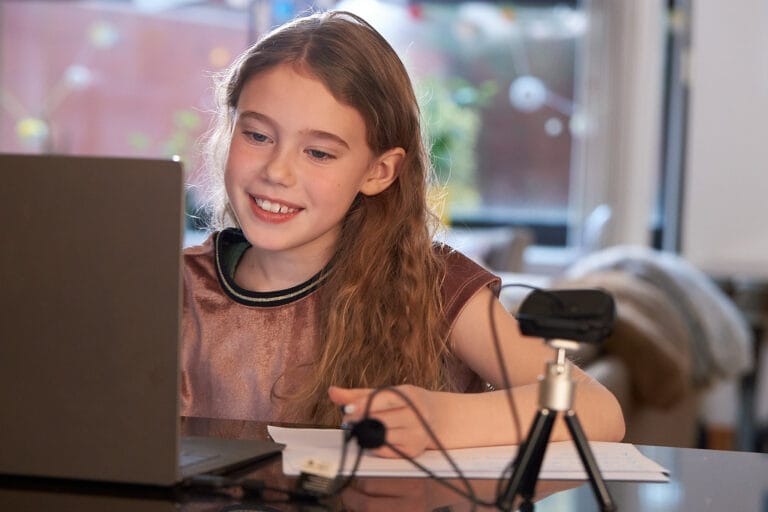

Kristin Martinez, M.A., CCC-SLP, Clinical Director, SLP & OT, acknowledges new provider concerns about how to keep students engaged in teletherapy in a new interview on the PresenceLearning blog.
What advice would you give to clinicians who are new to teletherapy about student engagement?
The fear that the connection between clinician and student will somehow be lost when services are provided via teletherapy is common among new telepractitioners. However, in my personal experience with my own students as well as based on experiences shared by my colleagues over the past seven years, this fear is generally unfounded. The students we are working with today are digital natives, and for them, connecting with others in an online environment is familiar, if not common. Engagement begins with those little connections we seek out with each of our students every session! However, some students will be more challenging to engage via teletherapy than others based on age, developmental levels, and areas of need.
The initial piece of advice I would give to clinicians who are new to teletherapy is to first consider how you would engage with your students if you were providing services in-person—start with the understanding of what supports, accommodations, or modifications would need to be in place if you were sitting in the same room as your student. It’s amazing what can be replicated in an online environment! Beyond that, it is important to understand the tools included in whatever platform you are using. Does your platform have an activity library? Are you able to add your own materials or incorporate web-based resources? What therapy-based features exist in your chosen platform to support both student engagement and behavior management? I was very fortunate to have started my teletherapy career with PresenceLearning which meant I have had access to an incredible platform that was developed exclusively for student-directed therapy services. Clinicians have informed the development of our platform over the past decade, and every feature exists to support us in our direct work with students.
The next piece of advice I would give to new teletherapists is to find your community of support! Look to those clinicians with school-based teletherapy experience, ask questions, and review shared resources. Every clinician has his/her tips and tricks when it comes to engaging students, and I have found my colleagues to be incredibly generous in their support of one another. Clinical teams are at the heart of PresenceLearning because we understand that every aspect of our work has an impact on students, and therefore must be informed and guided by clinical experience. We have teams of experienced teletherapists available to support new (and veteran!) clinicians throughout their journey with PresenceLearning, from clinical account managers who support providers as they navigate therapy assignments and caseloads, to our Clinical Connections program that gives providers the option to request 1:1 support from one of our clinical experts. Clinicians new to teletherapy can learn from our highly experienced clinical team how to best engage students as they develop their own tips and tricks!
How can clinicians best partner with parents or other support personnel to facilitate student engagement during teletherapy sessions?
Understanding the importance of on-site support when working with children via teletherapy, and more importantly, understanding how to work with parents or other support personnel to support online therapy sessions is one of the most important factors in successful teletherapy! When providing teletherapy services to students, a level of required support must be provided from an adult who is physically present with the student. If students are accessing therapy sessions from their homes, this support person will likely be a parent or guardian. If students are sitting in brick-and-mortar settings during therapy sessions, then the support person can be a paraprofessional or other staff member who has been assigned specifically to support related services. The level of in-person support required varies depending on each student’s age, developmental level, and degree of independence. Some three-year-olds are highly independent and able to engage with the clinician for online therapy, while some 16-year-olds require 1:1 support throughout each session. The level of support required tends to be similar to that which a student needs in order to engage with general education when in the brick-and-mortar setting. If a student is largely independent throughout his/her day and generally able to participate in computer-based activities, it is likely that this student will require little more than line-of-sight supervision during a teletherapy session. However, if a student requires small-group or 1:1 support throughout the day, this is typically the level of support that will be required in order for the student to effectively engage in teletherapy.
How each clinician leverages the parent or other support person during a therapy session will vary depending on student needs, but it is of course always driven by the clinician’s clinical experience and student need. The parent or support person, based on the clinician’s guidance, might help with the following:
- Bring physical objects (e.g., favored toys or books; classroom tie-ins) to the computer that might facilitate a student’s progress, particularly when working with younger students
- Support positive behavior reinforcement or physical breaks
- Support student’s physical interaction with AAC device
Regardless of the level of student support required, communication is key! It is well worth the teletherapist’s time to meet with the parent or support person prior to starting therapy to discuss expectations and answer any questions they may have. Teletherapy services can be successful with students of all ages and abilities as long as the appropriate level of onsite support is in-place.
How do you keep students engaged online using the PL platform?
The PresenceLearning platform includes a tremendous library of materials, allows clinicians to upload their own activities, and also supports the incorporation of web-based materials. I believe that clinicians who work with students are some of the most resourceful and creative people out there, so just as when clinicians provide therapy in-person, each online activity is used in different and new ways depending on each student’s interests, needs, and goal areas! Here are some examples of ideas for engaging students as used by PresenceLearning clinicians:
- Fun GIFs shared with student paired with movement/performing actions
- Music and videos to support physical/brain breaks (yoga for kids, etc.)
- Use of a visual schedule/timer to support attention and focus
- Using timers/competition if appropriate
- Allowing students the option to sit or stand—camera may just need to be adjusted!
- Moving outside if weather/internet permits!
- Using second camera with manipulatives (PlayDoh®, Legos®, sequencing objects)
- If in home setting, inviting sibling or parent to participate in an activity
- Barrier games
The possibilities are endless in the PresenceLearning platform as all activities and features have been designed with student-directed services and student engagement in mind!
What resources are available to clinicians using the PL platform?
The list of clinically impactful resources in the PL platform is continually growing—we’re always looking for new ways to make therapy engaging and fun for students and for our clinicians! These are some of the highlights:
- Vast materials library
- Ability to upload preferred therapy materials and also to incorporate web-based activities
- Integrated speech-language therapy, occupational therapy and psychoeducational assessments
- Multiple video feed and second camera integration capabilities to support both 1:1 and small-group sessions
- Ability to easily move between “jumbotron” and other video feed modes depending on different therapy session needs
- Individual clinical queues that allow clinicians to save and organize materials in any way that works best for their therapy sessions and schedule
- Fully interactive for student without mouse sharing
- Ability for clinician to enable/disable student mouse to support attention
- Built-in rewards including emojis and GIFs
- Ability to incorporate videos
- Full whiteboard capability and tools
- Incredible library of stamps that can be resized and moved for use with any other therapy materials in whiteboard
- Team Write—allows for interactive typing/editing
- Screenshare and Site Share capability for use of external web-based resources
What are some ways to re-engage students when they become distracted in their home environment?
Working with students who are joining teletherapy sessions from their homes can be more challenging as the clinician has little control over environmental factors (siblings, pets, etc.). As stated above, one of the most important factors when working with students from home is communication with the parent/guardian regarding what support might be needed during therapy sessions, but also about how to establish the best possible environment for therapy. We know that families are dealing with so much as schools are closed, so it’s essential that we have patience and empathy, as well as our own realistic expectations about what services might look like on the student’s side. However, that doesn’t mean that we can’t do our best to work with parents to create a therapy environment that will best support student engagement and effective therapy sessions.
If appropriate planning and expectation-setting has happened up front, it makes it easier to re-engage students when they do become distracted during a therapy session. To the greatest extent possible, minimize the possible distractions before therapy begins (e.g., suggest that the television not be on while the student is attending a therapy session, or that the computer be oriented in a way that supports the student’s focus on you vs. other activities in the home). While you are the expert in your area of therapy, parents are the experts on their children, so ask for their input! For instance, learning from the parents/guardians what they see as motivating to their child will give you a better idea of what they might support during therapy sessions. Maybe what worked as a reinforcer in the brick-and-mortar setting is not what parents are using at home, so find out what parents use to reinforce positive behavior. Do they tend to use games to reinforce behaviors, or snacks? Learn what the parent/guardian finds useful and see how you might integrate this information in order to engage/re-engage students.
Just as each student on your caseload responds to different types of reinforcers when you are providing therapy in-person, you will also learn how each of your students respond to online reinforcers. Some students can be re-engaged with the understanding that if they work for 5 more minutes, they will be able to engage in a preferred activity such as watching a short video or playing with stamps on the whiteboard. Other students may need regular physical breaks in order to stay engaged, so those breaks can be planned ahead of time so the students know what is expected of them before they are able do some jumping jacks or have a 1-minute dance party!



